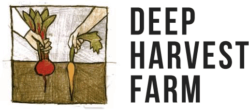It’s breathtaking: the naturally occurring biodiversity that magically appears to stake its claim on one’s organic field. Dozens of weed species, insect pests, and countess bacterial, viral and fungal diseases. Not to mention the vertebrates, which can’t be underestimated. These species put the ‘work’ in farming and keep us permanently on our toes. Here’s the first in a two-part series on the top tier nemeses that make their way into our daily farm lives. This week: Weeds! Next week: Diseases and Beyond!!! It’s a whimsical balance between letting all these scrappy cohabitants have their lunch and allowing us to make some cash.
WEEDS:
1. Hairy nightshade – Our most prolific and aggressive summer weed. Fast growing with a
strong root system, forming hundreds of small green berries packed with seeds.
2. Lambs quarter – A nutrient rich relative of spinach and quinoa, it’s our fastest growing weed and a producer of thousands of minuscule seeds per plant.
3. Canada Thistle – Our most existentially threatening weed. Thistle forms aggressive horizontal roots systems that are aggravated and spread from digging and tillage. In a pasture it may be managed by repeatedly mowing, but in annually worked vegetable fields there are no real organically-certified suppression methods. We tried tarping, digging, burning and an organic herbicide, which it all laughed off. Thus, we had to take one of our fields out of organic certification (and production) for the three years to spray a patch. It blows in every year from neighbors’ fields, and without a well-funded, county-wide management the problem with continue to worsen.
4. Field Bindweed – While this isn’t widespread on the farm, it has cropped up in a few locations and is spreading like wildfire. Like, thistle it forms spreading roots systems that we can’t figure out how to kill with organic methods. Unfortunately, we’re going to have to pull out two new beds of strawberries, because it has spread aggressively under the black plastic. We’ll put this area into pasture for a few years and mow it like crazy in an effort to wear this plant out.
5. Chickweed – Our most serious cool-season weed, but not a huge nuisance. Once the fall crops mature, we let chickweed run rampant, as it doesn’t compete with the crops at that point and acts as a makeshift cover crop. It can be a pain though during our super long, wet springs.
